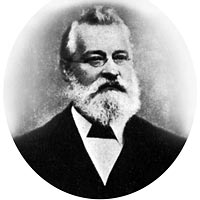

 Beginning in 1863, John Alexander Reina Newlands (born 1837, died 1898, shown at right→) in a series of short notes to the weekly
Beginning in 1863, John Alexander Reina Newlands (born 1837, died 1898, shown at right→) in a series of short notes to the weekly Chemical News
, pointed out that the average of a triad is usually a multiple of 8. In the 20 August 1864 issue of Chemical News
(vol. x. p. 94) Newlands wrote:
Sir,—In addition to the fact stated in my late communication, may I be permitted to observe that if the elements are arranged in the order of their equivalents, calling hydrogen 1, lithium 2, glucinum 3, boron 4, and so on (a separate number being attached to each element having a distinct equivalent of its own, and where two elements happen to have the same equivalent, both being designated by the same number), it will be observed that elements having consecutive numbers frequently either belong to the same group or occupy similar positions in different groups, as in the following examples:—
|
Group a " b " c " d " e |
No. N 6 O 7 Fl 8 Na 9 Mg 10 |
No. P 13 S 14 Cl 15 K 16 Ca 17 |
No. As 26 Se 27 Br 28 Rb 29 Sr 30 |
No. Sb 40 Te 42 I 41 Cs 43 Ba 44 |
No. Bi 54 Os 50 - - Tl 52 Pb 53 |
Here the difference between the number of the lowest member of a group and that immediately above it is 7; in other words, the 8th element starting from a given one, is a kind of repetition of the first, like the eighth note of an octave of music. The differences between the numbers of the other members of a group are frequently twice as great; thus in the nitrogen group, between N and P there are seven elements; between P and As, 13; between As and Sb, 14, and between Sb and Bi, 14.
Thus Newlands presented a table he claimed organized and numbered the elements primarily by equivalents (valence) despite printed separation lines that seem to suggest primary organization by atomic weight. The elements within a row of equal equivalents are secondarily sequenced by the still not well established atomic weights. (Note the numbers are their sequence, not actual atomic weights, and that telurium and iodine are out of order in their column.) By 1865 Newlands called this the Law of Octaves.
| No. | No. | No. | No. | No. | No. | No. | No. |
|
H 1 Li 2 G 3 Bo 4 C 5 N 6 O 7 |
F 8 Na 9 Mg 10 Al 11 Si 12 P 13 S 14 |
Cl 15 K 16 Ca 17 Cr 19 Ti 18 Mn 20 Fe 21 |
Co & Ni 22 Cu 23 Zn 25 Y 24 In 26 As 27 Se 28 |
Br 29 Rb 30 Sr 31 Ce & La 33 Zr 32 Di & Mo 34 Ro & Ru 35 |
Pd 36 Ag 37 Cd 38 U 40 Sn 39 Sb 41 Te 43 |
I 42 Cs 44 Ba & V 45 Ta 46 W 47 Nb 48 Au 49 |
Pt & Ir 50 Os 51 Hg 52 Tl 53 Pb 54 Bi 55 Th 56 |
Newlands proposals gained considerable ridicule from the English Chemical Society. There was little appreciation for the sigificance of atomic weights. The Chemical Society refused to publish his paper and one chemist wondered if an equally good arrangement could be obtained by alphabetizing the initials of the element names. Belatedly in 1887 The Royal Society awarded Newlands the Davy Award. Newlands died of influenza in July 1898.


| introduction | Greeks | alchemy | Lavoisier | Dalton | Berzelius | molecules | ↑ | spectra | electron | radiation | Bohr | isotopes | synthesis |
| to site menu | Discovery and Naming of Chemical Elements |
chemistry | physics | ||||||||||
| created 23 March 2002, addition 30 March latest revision 1 May 2010 |
by D Trapp | ||||||||||||